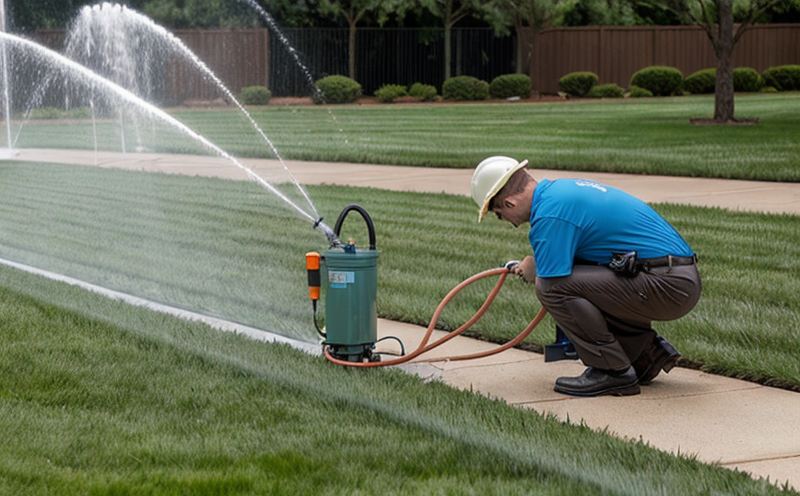Sprinkler system water pressure inspection
The sprinkler system water pressure inspection is a critical component in ensuring fire safety and protection systems function effectively during emergencies. This procedure involves measuring the hydraulic integrity of the entire sprinkler system to ensure it meets regulatory standards and operational requirements. The primary objective is to verify that each sprinkler head operates within the specified pressure range, thus guaranteeing prompt and effective water discharge when activated.
Water pressure in a sprinkler system can vary depending on several factors including elevation, pipe size, and distance from the water source. Compliance with specific standards such as ASME A126.1, NFPA 13, ISO/IEC 17025 is crucial to ensure uniform performance across different installations. The inspection process typically involves multiple steps:
- Reviewing system design and specifications
- Performing pressure checks at various points in the system
- Inspecting for leaks or blockages that could affect water flow
- Evaluating valve operation to ensure they can be opened quickly and fully during an emergency
- Assessing the integrity of piping and connections
The inspection also involves checking the pressure at different points in the system, which is essential for determining whether each sprinkler head will operate correctly. This step-by-step approach ensures that any issues can be identified early and addressed promptly.
For quality managers and compliance officers, ensuring proper water pressure within a sprinkler system is vital to maintaining operational readiness. R&D engineers benefit from this inspection as it provides insights into the performance of new or modified systems, helping them refine designs for better reliability and efficiency. Procurement professionals can leverage this information to select suppliers who provide high-quality components that meet stringent safety standards.
The importance of regular inspections cannot be overstated; they play a crucial role in maintaining compliance with relevant regulations such as NFPA 13, which mandates periodic testing to ensure fire protection systems are operational. By adhering to these guidelines, organizations can mitigate risks associated with potential failures and improve overall safety measures.
Benefits
Regular sprinkler system water pressure inspections offer numerous advantages that contribute significantly to enhancing organizational safety and compliance:
- Enhanced Safety: Ensures that all sprinklers will activate correctly during an emergency, providing immediate protection against fire outbreaks.
- Compliance Assurance: Helps organizations meet regulatory requirements set forth by entities like NFPA 13, ASME A126.1 and ISO/IEC 17025.
- Preventative Maintenance: Identifies potential issues early on before they escalate into major problems requiring costly repairs or replacements.
- Improved Efficiency: Ensures that water flows efficiently through the system, reducing waste and optimizing resource usage.
- Potential Cost Savings: By preventing failures, inspections help avoid expensive downtime and repair costs associated with non-functional systems.
- Risk Reduction: Minimizes the risk of property damage by ensuring timely intervention in case of fire outbreaks.
These benefits underscore why regular inspections are essential for maintaining a reliable fire protection system that can be counted on during critical moments. Organizations must prioritize these checks to uphold standards and protect both their assets and personnel from harm.
Industry Applications
| Application Area | Description |
|---|---|
| Data Centers | Data centers require stringent fire safety measures due to the valuable equipment and sensitive information housed within. Regular inspections ensure that sprinklers operate correctly in case of a fire, protecting critical infrastructure. |
| Commercial Buildings | In commercial buildings, sprinkler systems are integral for providing immediate protection against fires, helping to reduce property damage and protect occupants' safety. |
| Industrial Facilities | Industrial facilities often have extensive premises where rapid response is necessary. Sprinkler systems play a vital role in controlling potential fire hazards, ensuring swift containment of any outbreak. |
| Hospitals | Hospitals must maintain unimpaired sprinkler systems to safeguard patients and staff during emergencies. Regular inspections ensure that these critical components function as intended. |
| Residential Buildings | Even in residential settings, proper fire protection is paramount. Sprinklers provide an immediate response to fires, minimizing risks to residents' lives and properties. |
These applications highlight the diverse range of environments where sprinkler systems are used and why regular water pressure inspections are necessary for maintaining their effectiveness.
Competitive Advantage and Market Impact
The ability to accurately inspect and maintain a sprinkler system’s water pressure gives organizations a significant competitive edge in several ways:
- Innovation Leadership: Organizations that prioritize regular inspections demonstrate their commitment to innovation, ensuring they stay ahead of evolving fire safety standards.
- Risk Management: By mitigating risks associated with potential failures, these inspections enhance overall risk management strategies, contributing positively to organizational reputation and resilience.
- Cost Efficiency: Early identification of issues prevents costly repairs and replacements, optimizing operational costs while maintaining high performance levels.
- Customer Satisfaction: Providing reliable fire safety systems enhances customer confidence, fostering long-term relationships based on trust and reliability.
In the highly competitive market for fire protection solutions, organizations that invest in thorough inspections and maintenance services can differentiate themselves by offering superior products and services. This proactive approach not only strengthens their position but also contributes positively to the broader market's safety standards and compliance levels.





